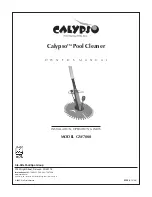
9
TROUBLESHOOTING
Hazardous suction. To avoid possible injury
from pool pump suction, always stop the pump when re-
moving or installing any attachment to the vacuum con-
nection or when cleaning the Calypso.
1. If your cleaner is not performing as it should, ALWAYS
check the following:
• Is the filter clean?
• Is the filter pump strainer basket clean?
• Is debris blocking the passage through the cleaner or
jamming the valve? If so,
STOP THE PUMP
and try to re-
move the debris from the bottom of the cleaner
using a finger. If this is not sufficient, simply unscrew
the nut and lift up the lid to reveal the chamber and
valve. Remove all debris and rinse the chamber be-
fore replacing the lid and reattaching the nut and
connecting tube.
• Is the correct amount of water being drawn through
the cleaner? (i.e., How much suction is there?)
Check flow as described in Step 5 on Page 5. Adjust
the valves of your filter system accordingly.
NOTE:
Optimizing the water flow does not mean maxi-
mizing the flow through the cleaner. Excessive suction may
make your cleaner hug the base of the pool walls. In fact,
to ensure a random pattern of travel that will enable the
Calypso to reach all areas of your pool, it is better to use
less suction, not more.
• If suction through the cleaner remains inadequate
even after closing off alternate intake sources, your
pump and filter system may be too weak or you
may have a constriction in the hose or the filtration
system itself. You may need to consult your pool
professional about corrective action.
• Is debris constricting the flow through the hose
and/or regulator valve? This will make your cleaner
appear sluggish, even though the valve indicates
good suction. Stop the pump and detach the hose
and valve for inspection. Inspect the hose section by
section.
• Are there any leaks in the hose? Replace leaky sec-
tions with genuine Calypso hose sections.
2. If your Calypso is not moving or is working slowly:
• Do the checks listed in (1) above to make sure that
the system is clean and an adequate amount of
water is being drawn through the Calypso.
• S
TOP THE PUMP
, open the lid of the Calypso and
make sure that the flapper valve is properly clipped
onto the steel shaft.
• S
TOP THE PUMP
and check that the flapper valve is
not worn or damaged.
• S
TOP THE PUMP
and check that the foot-pad is not
worn through.
• S
TOP THE PUMP
and check that the vacuum seal is not
wearing thin.
3. If air bubbles are noticeable at the return jets:
• Check for leaks in the hose.
• Is the water level below the level of the regulator
valve or another intake source? If so, raise the water
level until all intake sources are submerged.
• Make sure the the pump strainer lid is not leaking;
check the O-ring seal.
• Adjust the filter system valve to allow a small quan-
tity of water through the floor drain or another in-
take source that may have been shut off completely.
This will often eliminate the bubbles.
4. If the cleaner travels in a repetitive pattern and does
not visit sections of the pool:
• Check that the cleaner and hose are balanced. See
Figure 12, Page 7, for information on balancing the
hose.
NOTE:
The closer that the weight is to the cleaner, the
smaller the patterns of travel over the pool floor and walls.
However, putting the weight too close to the cleaner may
make it nose-heavy.
























